Navigation: Index page
First Ascent of the Northeast Ridge of Mt. Vancouver in 1975
This is arguably my most significant trip. It was done with M.I.T.
Outing Club people in 1975, nearly 50 years ago as I edit this web
page. We made the first ascent of the Northeast Ridge of
Mt. Vancouver in the St. Elias range, Yukon Territory, Canada.
Mt. Vancouver reaches 15,825 feet, the 15th highest mountain in North
America. The relief is huge. The summit is only about 23 miles from
the ocean in Disenchantment Bay and the surrounding glaciers are at
roughly 5000 ft elevation. The expedition spent 26 days in some of
the most isolated and rugged country in North America. The only other
people we saw during the whole time were a ranger and helicopter pilot
who visited very early in the trip during a mission to set a fuel
cache in the central part of the range and the helicopter pilot who
flew two of our group and our climbing supplies out of the range
before the rest walked out. It took 7 days, 6 on snow and ice, to
reach the nearest civilization at Kluane Lake on the Alaska Highway.
The following is the article written by Barton DeWolf and published
in the 1976 issue of the American Alpine Journal. It describes our
climb.
"Mount Vancouver, Northeast Ridge. The 1975 M.I.T. Outing Club
Expedition assembled in mid-June at Haines Junction. We consisted of
Cliff Cantor, Bob Dangel, Paul Ledoux, Rob Milne, Hal Murray, Bob
Walker, John Yates and me as leader. We conversed briefly with a
Japanese party that had just completed an ascent of the north side of
Mount Vancouver, a route we had considered as a possible alternative
if we found the northeast ridge impractical. On June 16 in the
evening, we were transported in three helicopter loads to a strikingly
beautiful location near the base of the northeast ridge at 4800 feet
on the Hubbard Glacier. The ridge above us rose in a series of steps
to a snow-covered peak at 10,600 feet, above which it widened and
became easier, merging with the main summit mass at 11,500 feet. We
planned a high camp just beyond P 10,600, from which we felt we might
push to the summit in one day. Climbing at night to obtain better snow
conditions, we explored route possibilities and established Camp I
above an active icefall which guarded a large, amphitheater-like basin
on the south side of the ridge. From here, we were able to reach the
8200-foot plateau on the ridge with relative ease, occupying Camp II
on June 22. We fixed 1100 feet of rope below the plateau to facilitate
load carrying. Above the plateau, the ridge rose in three steps to P
10,600, the first step being the most difficult. This was a
triangular-shaped face of rock and snow with sharp edges and steep,
snow-filled gullies. On the night of June 24, Murray and I climbed up
the right side of the face and on to the corniced, knife-edged ridge
beyond while Ledoux, Milne, Walker, and Cantor fixed 1600 feet of rope
up the central gully. On the night of June 26, following a snowstorm,
Murray, Yates, and Cantor fixed 500 feet of rope along the knife-edged
ridge, while Walker, Milne, and I fixed another 1000 feet up the
central gully of the second step and climbed on over easier terrain to
the summit of P 10,600. On the night of June 27, all of us packed
loads to Camp III just beyond P 10,600, the rapid progress made
possible by virtue of the fixed rope. The night of June 28 was clear
and calm. Carrying only bivouac gear, we passed one final ice pitch on
the ridge, then intersected the main summit mass up which we climbed
with ease. We reached the north summit (15,825 feet) the highest, at
about nine A.M. on June 29. The descent was tiresome and slow, but we
finally reached Camp III after 17 hours of climbing. By the morning of
July 3, we were all back in Base Camp, having removed our fixed ropes
and equipment. Dangel and Milne flew back to Haines Junction with most
of the climbing gear on July 5, while the rest of us donned skis and
shouldered packs for an overland return via the Hubbard and Kaskawulsh
Glaciers. We covered 68 miles of spectacular glacial terrain during
the next seven days, arriving back at Kluane Lake on July 11.
Barton DeWolf"
While we were getting ready for our flight, we met a Japanese party
that had just climbed Mt. Vancouver from the north, using what we
had considered as a backup route.
Mt. Vancouver has three summits of nearly equal height. The south
summit is one of the defining markers of the U.S. - Canada border. We
climbed the north summit which is thought to be the highest of the
three by a small margin. A proper analysis of the photo taken toward
the South Summit from the North Summit might be able to help confirm
which is highest, but a casual analysis is hampered by a hazy horizon
over the ocean.
Note that I was known as Bob Walker in the Outing Club. My full name is
Robert Craig Walker and I normally go by my middle name. My attempts
to switch to Bob in college failed, other than in the Outing Club,
because too many people knew my family and knew me as Craig.
As noted, the trip was nearly 50 years ago. Since then, three members
have passed away (Ledoux, Dangle, and Milne (on Everest)) and
the other five are still around and in touch. In fact, this upgrade of
my web page was triggered by a discussion among our group.
Photographic details:
The photos were taken on Kodachrome 25 or 64 (I forget which) which were
new at the time and had a color balance issue. The camera was a Konica
Autoreflex T3. Shortly after the trip, I made a slide show of 122 images.
Most, but not all, were mine. Some were duplicates. Unfortunately the
slide duplication technology (slide to slide) was not too good, so the
quality of those duplicates was not so great.
I had a dozen slides digitized to PhotoCD in 1996 as part of a
come-on offer when I bought a printer. Later I acquired a Minolta
Dimage Scan Elite film scanner which I used in 2006 to scan the first
56 images. But that is fairly tedious, and I got very busy so I did
not finish the project. The scanner was always fairly slow, and then,
when I got my Mac Pro in 2009, basically became obsolete because of
its SCSI interface. The project languished until I retired at the end
of 2014. I then set up my DSLR, a Pentax K5 with a 100mm macro lens,
on a kludged mount using the slide holding end of an old slide
duplicator (originally for the Konica) and proceeded to copy the rest
of the slides by photographing them. The raw (DNG) images were
processed in Lightroom. I also went back to the tif files from the
scanning and redid most them in Lightroom for consistency. In the
end, I think the best copies, and certainly the highest resolution
(although the resolution is film limited) were from the camera so
that worked well. One side effect is that the EXIF data associated
with the photos are for the duplication process, not the original film
photograph.
The duplicates are labeled in the captions as such. Those photos
were taken by other members of the party. Several appeared in a
recent slide show by Bart DeWolf, so were taken by him. It is possible
that they are all from Bart. I needed other's photos because it was
too dark on my helicopter flght in, and my photos of the key ridge
climb were underexposed.
These photos were scanned recently from nearly 50 year old slides.
The slides are still in near perfect condition.
Kodachrome is very good film.
Now the photos. Click on the small photo or the caption to see a
larger version, suitable for screen viewing. Full size versions are
available on request.
Click on the image for a screen size version.
The "2000" and "full size" versions are larger (not available in web versions).
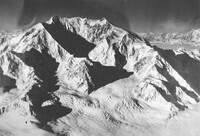
A photo by Brad Washburn of the east side of Mt Vancouver. Bart was in
consultation with Brad Washburn on possible routes and Brad requested this photo
and some others from the National Geographic Society once we were reasonably
sure of which routes interested us.
|
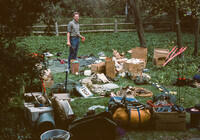
Inspecting and sorting gear at Pine Creek Campground near Haines
Junction. My logs say Pine Creek Campground, but modern maps show
a Pine Lake Campground in about the right place.
|
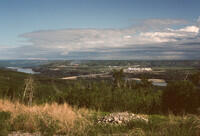
Along the Alaska Highway. Some of the crew flew to Whitehorse. Others
drove a van up the highway.
|
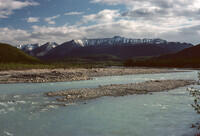
Somewhere along the Alaska Highway.
|
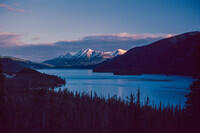
A lake along the Alaska Highway. I don't recall which.
|
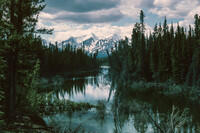
Yet another scene along the Alaska Highway.
|
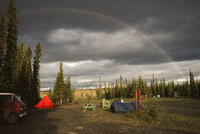
This is probably our staging area at Pine Creek Campground.
|
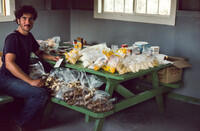
Packing the food. We packed the food in bags, each meant for one full
day for 4 people. A single such bag fed all
8 of us at the start of the trip. Two bags were about right for the climb.
On the hike out, when we had 6 people, we had 6 man day packs which left
us hungry. We were burning a lot of energy.
|
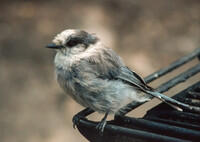
A camp robber.
|
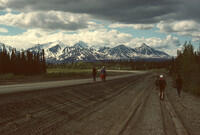
Walking along the Alaska Highway. The airport was pretty close to camp,
so we may have been going there.
|
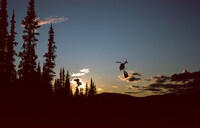
The first of the three helicopter flights to our Base Bamp left at 8 pm
on June 16, 1975.
It was basically dark for the third flight, which I was on.
|
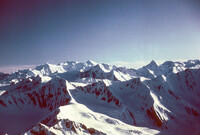
Duplicate. Part of the St. Elias range from the flight in. It was too
dark during my flight to take photos, so these
are from someone, probably Bart, on the first flight.
|
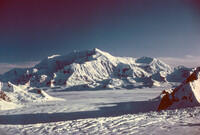
Duplicate. A view of our target, Mt Vancouver, from the flight in. The
upper part of the northeast ridge is roughly centered in the photo. The
lower part of the ridge curves around to the left.
|
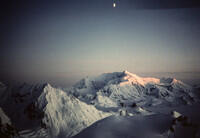
Duplicate. Another view of Mt Vancouver with the Northeast Ridge centered.
This looks darker and from a higher flying helicopter so it might be from
the second flight, in which case it was taken by Rob Milne.
|

The helicopter at Base Camp. We're back to my photos. It never really
got completely dark. In fact, we did most of our climbing at night for
firmer snow and fewer avalanches.
|
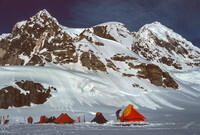
Our Base Camp on the Hubbard Glacier below the Northeast Ridge of
Mt. Vancouver. We explored
several options for how to start the climb and didn't really like any
of them because of possible avalanche issues.
|
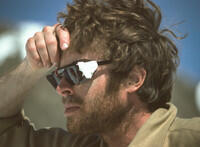
Bart DeWolf.
|
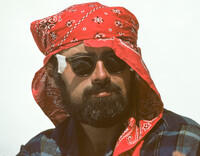
Paul Ledoux
|
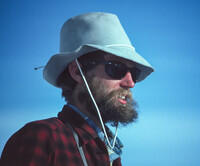
Hal Murray
|
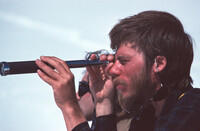
John Yates
|
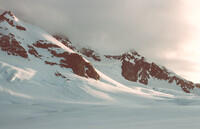
Looking northwest along the side of Mt Vancouver.
|
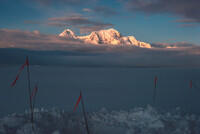
Mounts Hubbard and Alverstone, both US/Canada border peaks, from our camp.
|
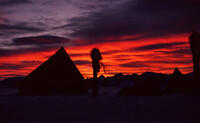
A sunset picture from Base Camp.
|
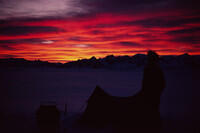
Another sunset picture from Base Camp.
|
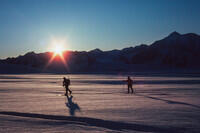
We skied along the glacier to examine various possible starts.
|
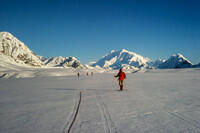
Another scene from our ski along the Hubbard Glacier. The big mountain in the
background is Mt. Logan, the highest in Canada, second highest in North
America, and one of the bulkiest mountains in the world. It's seen end
on here.
|
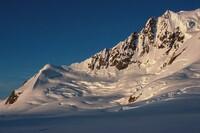
The lower part of the East Ridge of Mt. Vancouver.
|
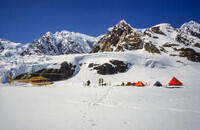
On June 18, at Base Camp, we watched a helicopter place a cache of fuel on
the ridge above our camp - the wide, smooth snow structure in the center of this
picture. They then dropped by for tea and a chat. We had been sleeping
because of our night schedule.
|
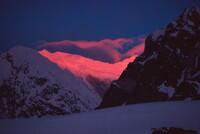
Sunset alpenglow looking up Mt. Vancouver.
|
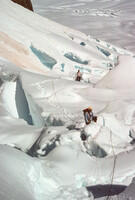
We opted to take a route up the icefall south of the toe of the Northeast
Ridge. Being among the seracs was a bit freaky, but did not seem as
dangerous as being below obvious avalanche chutes on other alternative routes.
|
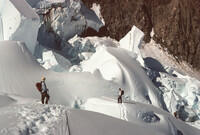
More seracs in the icefall. We made multiple trips through this to move
all our gear. On the way down nearly 2 weeks later, we found some of our
tracks on the sides of seracs. Clearly there had been motions.
|
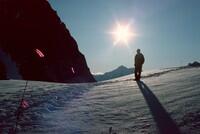
We camped first above the icefall at about 6400 ft, then made an
Advance Base Camp (Camp 2) on a large shoulder at around 7700 ft.
Basecamp on the Hubbard Glacier was at around 4500 ft.
|
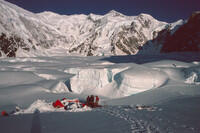
This is the first camp just above the icefall with the summmit of Mt.
Vancouver in the background.
|
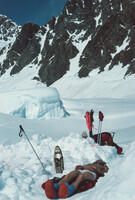
With our night climbing schedule, sleep time wasn't very cold despite
all the ice. We joked about emergency bivouac gear being a tube of sun
screen and a turban.
|
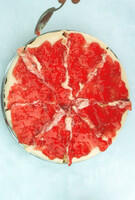
Dessert from one of our meals.
|
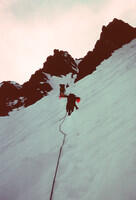
Duplicate. Climbing from the first camp above the icefall to the shoulder
where we put the Advance Base Camp. We placed some fixed rope in here because
of the multiple trips and very heavy packs.
|
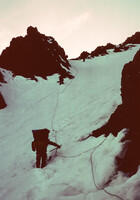
Duplicate. Higher in the gully leading to the shoulder.
|
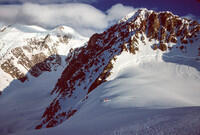
The Advance Base Camp on the shoulder. We placed the camp
slightly down the side of the shoulder for some extra shelter from
the wind. Our route from here went straight up the right of the two
main gullies on the face above camp. That gully tops out where the
two sides of the face converge.
|
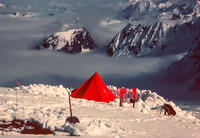
Duplicate. One of the tents at Advance Base Camp. The black plastic
sheet in the foreground was an attempt, somewhat successful, to melt
snow without using fuel.
|
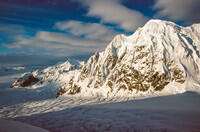
Looking from Advance Base Camp on the Northeast Ridge of Mt Vancouver toward
the East Ridge of Mt Vancouver and Mt. Foresta in the distance.
|
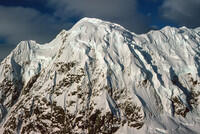
The cornices along the East Ridge of Mt. Vancouver. There were frequent
avalanches on this face.
|
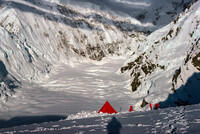
Looking up the valley between the East and Northeast Ridges of Mt Vancouver.
A later party, I believe, used that valley to get to a more direct
approach to the peak. Given the avalanches we saw, that seems very
dangerous.
|
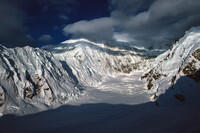
A wider angle shot of the same valley as the last picture.
|
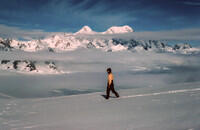
Bart with Mounts Hubbard and Alverstone in the background.
|
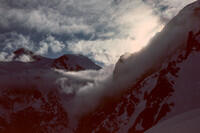
From Advance Base Camp
|
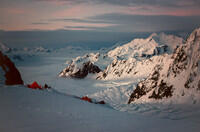
Advance Base Camp looking over Mt. Foresta and the Hubbard Glacier
|
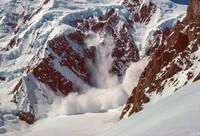
An avalanche across from Advance Base Camp.
|
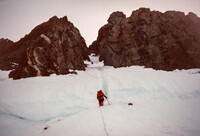
Climbing the gully above Advance Base Camp. We fixed ropes in the gully.
After moving to the high camp, and climbing the summit, on descent we
found some of those ropes broken from snow/ice/rock fall.
|
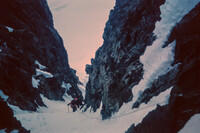
Duplicate. In the gully. My photos of this section and the ridge are
underexposed so these are duplicates of slides from others, probably Bart.
|
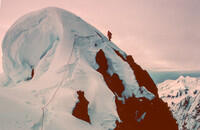
Duplicate, probably from Bart. Along the ridge above the gully. Some
of these cornices had fallen by the time of our descent.
|
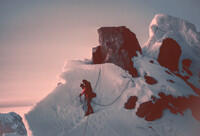
Duplicate. Photo by Bart DeWolf. Another shot of climbing along the
ridge. I believe the climber is Hal Murray.
|
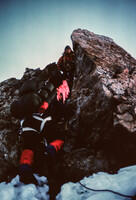
Duplicate. Photo by Bart DeWolf. A rock step along the ridge. The
climber is me (based on clothes and gear).
|
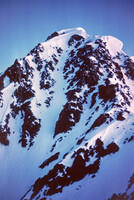
Duplicate. Photo by Bart DeWolf. After a stretch of roughly
horizontal ridge, we had another gully to traverse to and climb. This
one was wider and easier than the first. At least two climbers are
visible in this photo. There should be 4 on the rope but they are
hard to distinguish from the rocks. On the way down, Paul's sleeping
bag detached from his pack in this area. Days later it was recovered
from the glacier far below.
|
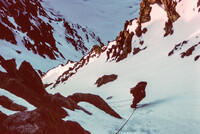
Duplicate, Probably from Bart. Climbing the upper gully.
|
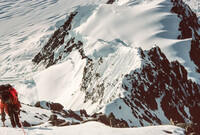
Back to my photos. Looking down the Northeast Ridge of Mt. Vancouver
from the top of the upper gully. The route traversed the sharp ridge
to where it splits, which was at the top of the lower gully. Part
of Advance Base Camp can just be seen on the wide shoulder below to
the right of the right branch of the ridge. The climber might be Bart.
|
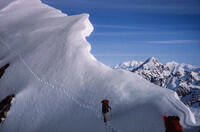
Following the ridge above the upper gully, trying to stay well back
from the edge.
|
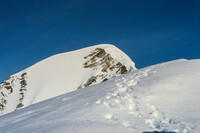
Continuing above the gullies. A 4 man team is visible in the distance.
|
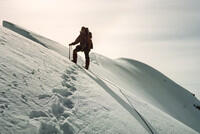
Rob Milne and our tracks along the back side of the cornices.
|
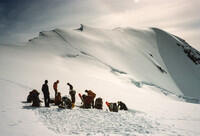
Placing our high camp at about 10,500 ft above the technical sections.
|
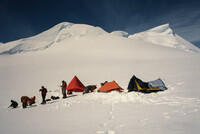
Looking ahead from the high camp (Camp 3). There were some short,
low-angle, ice slopes above here, but it was mainly a snow slog to the
summit.
|
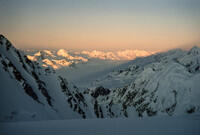
The view from the high camp.
|
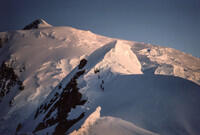
There was still some relatively easy ridge above the high camp. We
originally intended to place another camp, but, with good weather in
hand, decided to make a one day push to the summit during the night
of June 28-29 and well into the following day.
|
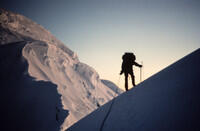
More of the final ridges and cornices. Note the 4 man team above the
cornice at the bottom of the photo.
|
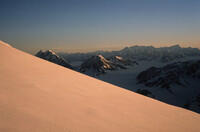
A low-light view of more of the St. Elias Range looking more or less northwest.
|
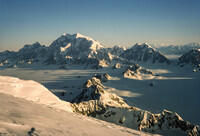
After rounding more onto the north side of the Mt. Vancouver, we could see
Mt. Logan and the Bagley Icefield (Seward Glacier), along with the Hubbard
Glacier to the right.
|
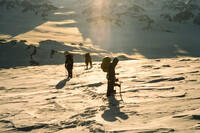
Most of the climb to the summit was on the large northern snowfield. It was
easy going, although, according to my logs, John Yates and I were slowed
by the altitude.
|
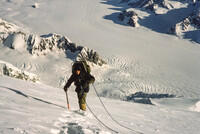
Bob Dangle with the Hubbard Glacier below.
|
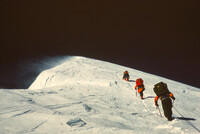
Duplicate. The lead team approaching the summit. The two teams got
separated by enough that our times on the summit did not overlap. But
all 8 of us made the top.
|
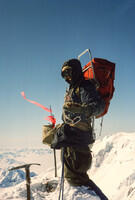
Cliff Cantor on the summit (north peak) of Mt. Vancouver. At an
altitude of 15,825 ft, it is the 15th highest mountain in North America.
Note that there is a range of elevations of 200 or more feet given in
various references.
|
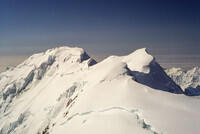
This photo was taken from the North Summit looking toward the Middle and
South Summit of Mt. Vancouver. In principle, a careful analysis might
be able to settle the question of which is higher, especially because
the distant horizon is over ocean. Unfortunately there are haze and
low clouds that make that problematic.
|
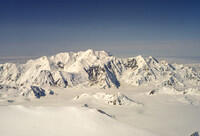
Mt. Cook seen from the top of Mt. Vancouver. This is the next border
peak going west from Mt. Vancouver.
|
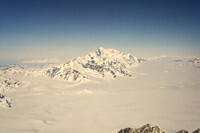
Mt. St. Elias seen from the top of Mt. Vancouver. At 18,008 ft, St. Elias
is the 4th highest mountain in North America. The summit is only 12 miles
from an arm of the Pacific Ocean in Icy Bay.
|
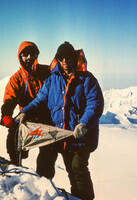
Duplicate. Bart DeWolf (right) and Paul Ledoux on the summit of Mt. Vancouver
with the MIT Outing Club Flag.
|
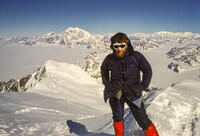
Bob Walker (Craig to most friends now) on the summit of Mt. Vancouver with
Mt. Logan in the background.
|
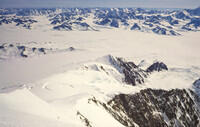
Looking down the Northeast Ridge of Mt Vancouver, our route, from the summit.
|
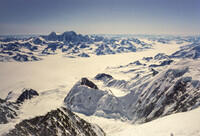
The Hubbard Glacier with Mounts Hubbard (right) and Alverstone (left)
beyond. Both of these are border peaks.
|
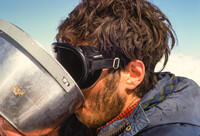
Cliff Cantor hydrating. We took a stove to melt snow on the summit
push.
|
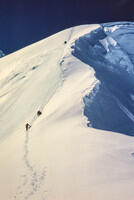
Duplicate. One of ice patches (slightly darker snow under the rope) that
we crossed on the summit push.
|
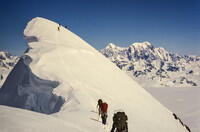
Heading back down past the cornices with Mounts Hubbard and Alverstone
in the background.
|
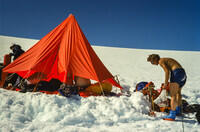
At our high camp in fine weather.
|
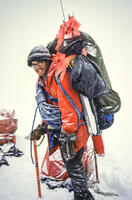
We slept the night after the summit, then started down the following night.
The weather had gone bad, with some fresh snow. This is Bart preparing to
start down. Because of the weather, I don't have pictures of the descent.
The snow was soft, and some of the cornices had fallen since our ascent. The
gullies had clearly experienced much snow/ice/rock fall.
|
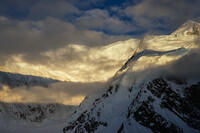
A view toward the summit from lower on Mt. Vancouver.
|
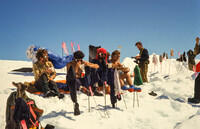
Back at Advance Base Camp, and fine weather. Our wands were handy drying
racks. The people, left to right, are Bart, Cliff, Paul, Hal (almost hidden),
Rob, and John. By elimination the hand and leg to the right are Bob assuming
I took the picture.
|
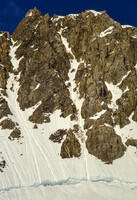
Our gully in the center of the picture. Much of the snow in it before the
climb is gone. Note we cleared all of our gear, including the fixed ropes,
off the mountain before leaving.
|
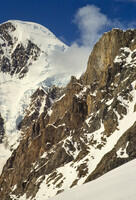
Looking back up the mountain from Advance Base Camp.
|
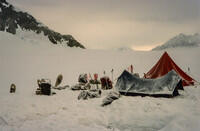
Back on the Hubbard Glacier after completing the first ascent of the
Northeast Ridge of Mt. Vancouver. We had some more poor weather at
the end. In fact, my log indicates the highest winds of the trip were
at Base Camp after the climb.
|
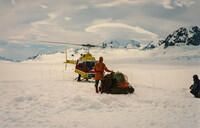
To finish off the trip, Bob Dangle and Rob Milne flew out to meet other
committments. With them went most of our climbing gear, trash, and
anything we would not need for a week long hike to the Alaska Highway,
mostly over glaciers.
|
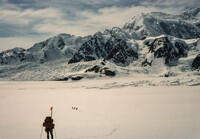
Starting the ski/hike out on July 5. Our Base Camp was about dead
center, on the Hubbard Glacier, in this picture. The first task was
to cross the glacier. Then we skied up the eastern arm of the Hubbard
Glacier to the headwaters of the Kaskawulsh Glacier. We skied and
hiked the full length of the Kaskawulsh to the Slims river, which we
followed to the Alaska Highway at Kluane Lake. We took 7 days, of
which two were cut short by illnesses.
|
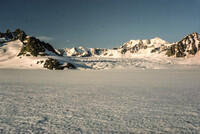
A view up a side glacier.
|
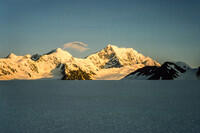
I believe this is Mt King George from the east branch of the Hubbard
Glacier to the mountain's east.
|
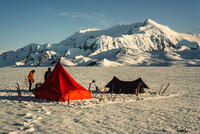
A hiking camp looking back toward Mt. Vancouver.
|
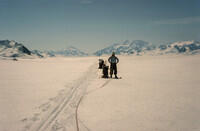
Antarctica? No, still on the eastern branch of the Hubbard Glacier
looking back on, I think, Mt. Foresta, just to the right of Paul.
|
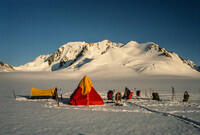
Another camp on the glaciers near the region of transition from
the Hubbard to the Kaskawulsh.
|
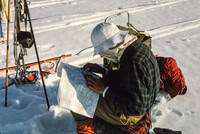
John Yates studying the map. There were glaciers going in many
directions and we had to hit the right one. This was long before
GPS.
|
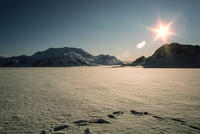
On the glaciers in the ice cap region.
|
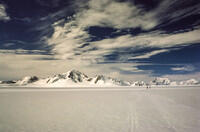
Another photo in the icecap region.
|
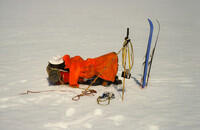
Taking a break.
|
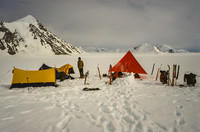
Another camp. The fly from my tent (the smaller North Face Mountain Tent)
is being used separately as a sun shade.
|
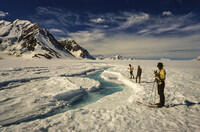
As we approached the region on the Kaskawulsh Glacier where there was net
melting, we started to see surface streams like this. Eventually they
would find a hole and plunge to the bottom of the glacier. Here we
are still on snow, but soon we will be on ice where there is net melting
each season.
|
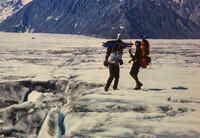
Duplicate. Now we're on the ice. We no longer need the skis, and, since
there are no longer hidden snow bridges over crevasses, we don't need the
ropes. Just don't step on something that looks like snow. Here I seem
to be trying to bash Cliff with my skis.
|
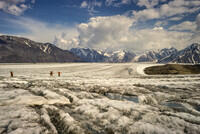
Heading down the Kaskawulsh. Much was like a superhighway. But there
were occasional cravasse fields that took some effort to cross.
|
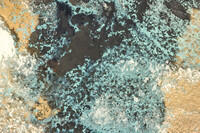
A close up of the dirty ice. As the ice melts, any dust and dirt that
was in it accumulates on the surface until, near the mouth, it does not
look like ice at all.
|
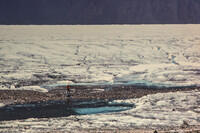
Duplicate. Some ponds along the surface of the glacier.
|
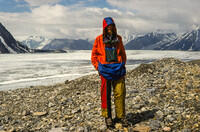
John Yates on a central moraine on the Kaskawulsh Glacier. The moraine
is a part of the glacier that that marks the the join between the ice
from two glaciers that merged upstream. Each of those feeder glaciers was
subject to rockfall along its edge. The accumulated rocks are exposed
as the surface melts and make the pronounced stripe down the middle
of the main glacier.
|
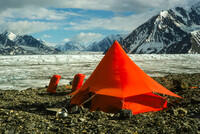
A camp on a central moraine.
|
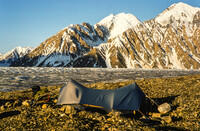
My tent at the same moraine camp. This was before the era of dome tents.
|
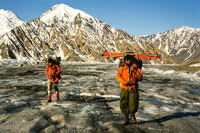
John Yates and Paul Ledoux walking down one of the "freeway" sections
of the Kaskawulsh Glacier.
|
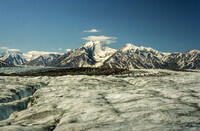
On the Kaskawulsh Glacier. Very often, when a photo of a classic valley
glacier is shown in a publication, it is the Kaskawulsh.
|
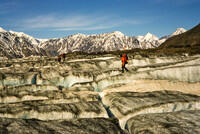
One of the crevasse fields. Usually the trick was to walk back and
forth along the ridges between the cracks to find a place to jump.
|
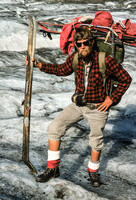
Hal Murray holding evidence of another long-ago traveler on the glacier.
|
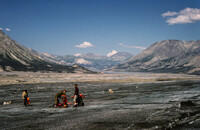
Approaching the snout of the glacier. At the end of the ice, the water
appears from underneith the north side of the glacier and becomes the
Slims River which flows to Kluane lake and eventually to the Yukon River.
On the south side, it becomes the Kaskawulsh River which flows to the
Alsek River and directly to the Pacific Ocean. Long after this trip,
a geological event happened and the Kaskawulsh River captured the full
flow from the Kaskawulsh Glacier. The Slims river basically dried up.
|
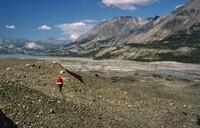
We're still on the glacier, but it's covered with rocks. Soon we
get off the ice and follow the south side of the Slims River.
|
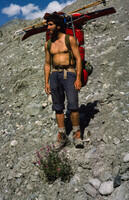
Cliff with our first plant in a month!
|
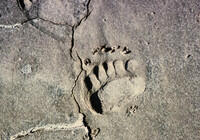
Duplicate. There are bears in this region. We didn't see any, but we
were a party of six and they probably avoided us.
|
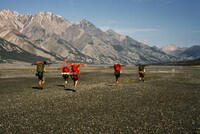
Hiking along the Slims River along an easy stretch.
|
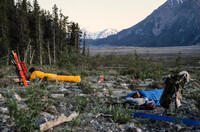
Our one campsite along the Slims River. We camped next to a stream
which we used for water since we now had no snow or ice to melt. We
had a bit of shock in the morning when the stream was gone - the snow
upstream had stopped melting. But we could hear it uphill from camp
so went to fetch water.
|
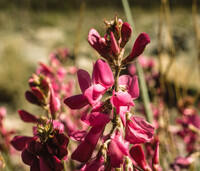
One of the flowers seen as we head for civilization and life.
|
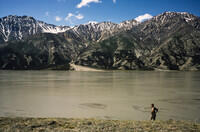
The Slims River, from before the recent capture of most of the water
by the Kaskawulsh River.
|
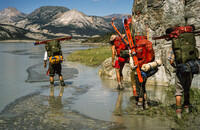
Thanks to spots like this, we ended up with wet and muddy boots. There
was some quicksand, but we didn't have much trouble with it, although Cliff
had an encounter.
|
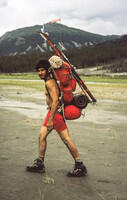
Cliff Cantor with his hike-out pack.
|
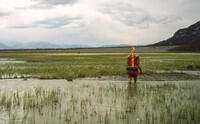
More wet boots. There were places like this that we couldn't really avoid.
|
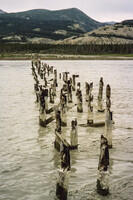
The remains of the old Alaska Highway bridge which we reached on July
11. Most of us waited at this location while Hal and Bart went for
the van. We were pretty famished when we finally got to a restaurant
in Haines Junction. Most had two full dinners.
|
Navigation: Index page

























































































































